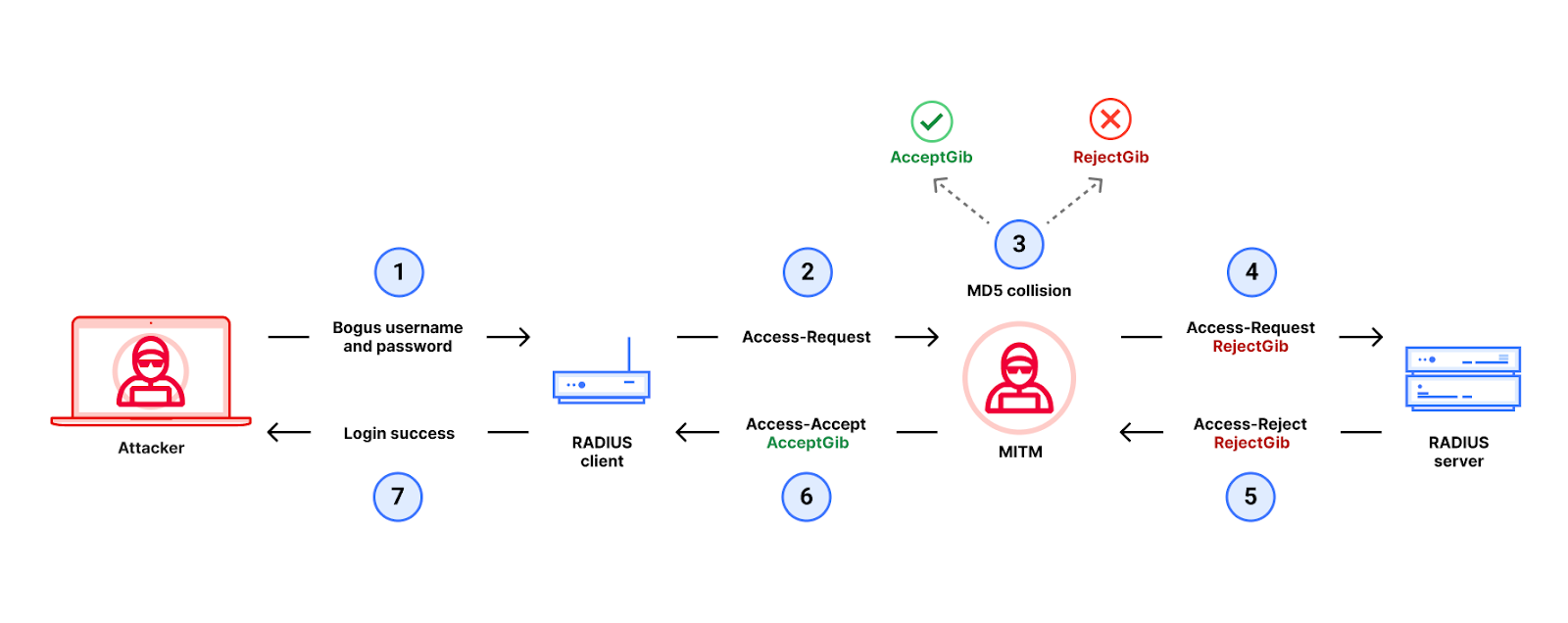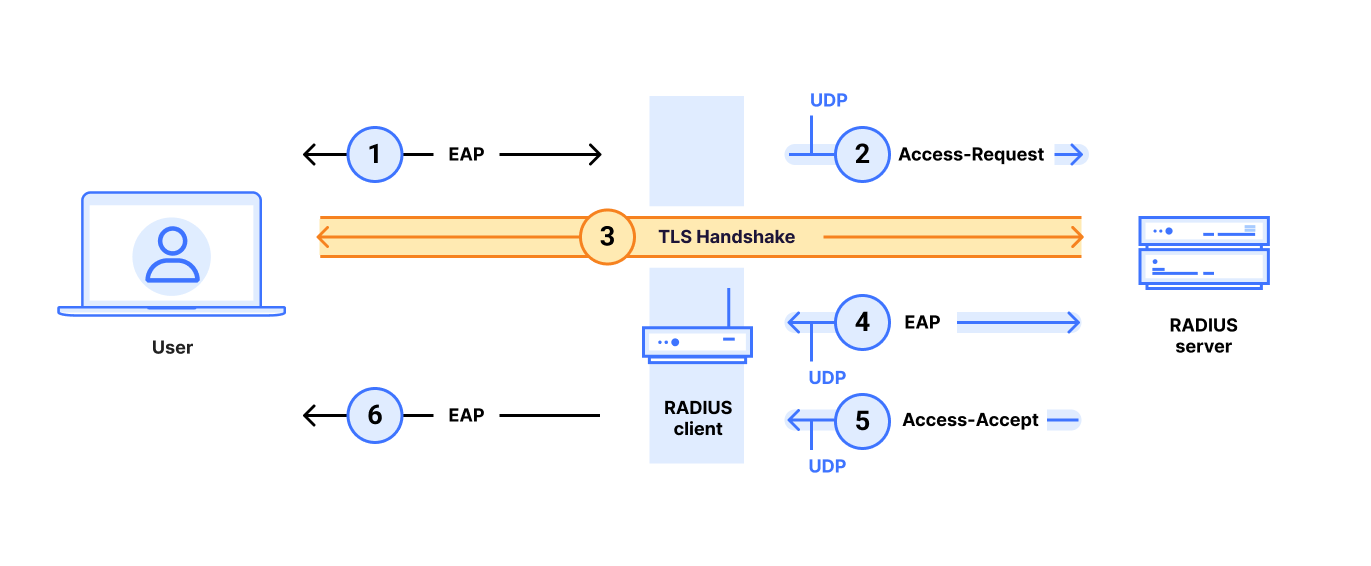07/09/2024
17 min read
The MD5 cryptographic hash function was first broken in 2004, when researchers demonstrated the first MD5 collision, namely two different messages X1 and X2 where MD5(X1) = MD5 (X2). Over the years, attacks on MD5 have only continued to improve, getting faster and more effective against real protocols. But despite continuous advancements in cryptography, MD5 has lurked in network protocols for years, and is still playing a critical role in some protocols even today.
One such protocol is RADIUS (Remote Authentication Dial-In User Service). RADIUS was first designed in 1991 – during the era of dial-up Internet – but it remains an important authentication protocol used for remote access to routers, switches, and other networking gear by users and administrators. In addition to being used in networking environments, RADIUS is sometimes also used in industrial control systems. RADIUS traffic is still commonly transported over UDP in the clear, protected only by outdated cryptographic constructions based on MD5.
In this post, we present an improved attack against MD5 and use it to exploit all authentication modes of RADIUS/UDP apart from those that use EAP (Extensible Authentication Protocol). The attack allows a Monster-in-the-Middle (MitM) with access to RADIUS traffic to gain unauthorized administrative access to devices using RADIUS for authentication, without needing to brute force or steal passwords or shared secrets. This post discusses the attack and provides an overview of mitigations that network operators can use to improve the security of their RADIUS deployments.

In a typical RADIUS use case, an end user gets administrative access to a router, switch, or other networked device by entering a username and password with administrator privileges at a login prompt. The target device runs a RADIUS client which queries a remote RADIUS server to determine whether the username and password are valid for login. This communication between the RADIUS client and RADIUS server is very sensitive: if an attacker can violate the integrity of this communication, it can control who can gain administrative access to the device, even if the connection between user and device is secure. An attacker that gains administrative access to a router or switch can redirect traffic, drop or add routes, and generally control the flow of network traffic. This makes RADIUS an important protocol for the security of modern networks.
Our understanding of cryptography and protocol design was fairly unrefined when RADIUS was first introduced in the 1990s. Despite this, the protocol hasn’t changed much, likely because updating RADIUS deployments can be tricky due to its use in legacy devices (e.g. routers) that are harder to upgrade.
RADIUS traffic is commonly sent over internal networks, and in our research we did not broadly measure how organizations configure it internally. Anecdotal evidence suggests that RADIUS/UDP remains popular. (See our paper for some case studies of large organizations using RADIUS/UDP). While it is possible to send RADIUS over TLS (sometimes also called RADSEC), the Internet Engineering Task Force (IETF) still considers the specification for RADIUS/TLS to be “experimental”, and is currently still in the process of specifying RADIUS over TLS or DLTS as “standards track”.

Prior to our work, there was no publicly-known attack exploiting MD5 to violate the integrity of the RADIUS/UDP traffic. However, attacks continue to get faster, cheaper, become more widely available, and become more practical against real protocols. Protocols that we thought might be “secure enough”, in spite of their reliance on outdated cryptography, tend to crack as attacks continue to improve over time.
In our attack, a MitM gains unauthorized access to a networked device by violating the integrity of communications between the device’s RADIUS client and its RADIUS server. In other words, our MitM attacker has access to RADIUS traffic and uses it to pivot into unauthorized access to the devices hosting the RADIUS clients that generated this RADIUS traffic. From there, the attacker can gain administrative access to the networking device and thus control the Internet traffic that flows through the network.

This Blast-RADIUS attack was devised in collaboration with researchers at the University of California San Diego (UCSD), CWI Amsterdam, Microsoft, and BastionZero. In response, CERT has assigned CVE-2024-3596 and VU#456537 and worked with RADIUS vendors and developers to coordinate disclosure.
RADIUS/UDP and its ad hoc use of MD5
RADIUS/UDP has many modes, and our attacks work on all authentication modes except for those using EAP (Extensible Authentication Protocol). To simplify exposition, we start by focusing on the RADIUS/UDP PAP (Password Authentication Protocol) authentication mode.
With RADIUS/UDP PAP authentication, the RADIUS client sends a username and password in an Access-Request packet to the RADIUS server over UDP. The server drops the packet if its source IP address does not match a known client, but otherwise the Access-Request is entirely unauthenticated. This makes it vulnerable to modifications by a MitM.
The RADIUS server responds with either an Access-Reject, Access-Accept (or possibly also an Access-Challenge) packet sent to the RADIUS client over UDP. These response packets are “authenticated” with an ad hoc “message authentication code (MAC)” to prevent modifications by an MitM. This “MAC” is based on MD5 and is called the Response Authenticator.
This ad hoc construction in the Response Authenticator attribute has been part of the RADIUS protocol since 1994. It was not changed in 1997, when HMAC was standardized in order to construct a provably-secure cryptographic MAC using a cryptographic hash function. It was not changed in 2004, when the first collisions in MD5 were found. And it is still part of the protocol today.
In this post, we’ll describe our improved attack on MD5 as it is used in the RADIUS Response Authenticator.
The RADIUS Response Authenticator
The Response Authenticator “authenticates” RADIUS responses via an ad hoc MD5 construction that involves concatenating several fields in the RADIUS request and response packets, appending a Secret shared between RADIUS client and RADIUS server, and then hashing the result with MD5. Specifically, the Response Authenticator is computed as
MD5( Code || ID || Len || Request Authenticator || Attributes || Secret )
where the Code, ID, Length, and Attributes are copied directly from the response packet, and Request Authenticator is a 16-byte random nonce and included in the corresponding request packet.
But the RADIUS Response Authenticator is not a good message authentication code (MAC). Here’s why:
- First, let’s simplify the construction in the Response Authenticator as: the “MAC” on message X1 is computed as MD5 (X1 || Secret) where X1 is a message and Secret is the secret key for the “MAC”.
- Next, we note that MD5 is vulnerable to length extension attacks. Namely, given MD5(X) for an unknown X, along with the length of X, then anyone who knows Y can compute MD5(X || Y).
Length extension attacks are possible because of how MD5 processes inputs in consecutive blocks, and are the primary reason why HMAC was standardized in 1997. - This block-wise processing is also an issue for the Response Authenticator of RADIUS. If someone finds an MD5 collision, namely two different messages X1 and X2 such that MD5(X1) = MD5(x2), then it follows that MD5 (X1 || Secret) = MD5 (X2 || Secret).
This breaks the security of the "MAC". Here’s how: consider an attacker that finds two messages X1 and X2 that are an MD5 collision. The attacker then learns the "MAC" on X1, which is
MD5 (X1 || Secret). Now the attacker can forge the “MAC” on X2 without ever needing to know the Secret, simply by reusing the “MAC” on X1. This attack violates the security definition of a message authentication code.
- This attack is especially concerning since finding MD5 collisions has been possible since 2004.
The first attacks on MD5 in 2004 produced so-called “identical prefix collisions” of the form
MD5 (P || G1 || S) = MD5 (P || G2 || S), where P is a meaningful message, S is a meaningful message, and G1 and G2 are meaningless gibberish. This attack has since been made very fast and can now run on a regular consumer laptop in seconds. While this attack is a devastating blow for any cryptographic hash function, it’s still pretty difficult to use gibberish messages (with identical prefixes) to create practical attacks on real protocols like RADIUS.
In 2007, a more powerful attack was presented, the “chosen-prefix collision attack”. This attack is slower and more costly, but allows the prefixes in the collision to be different, making it valuable for practical attacks on real protocols. In other words, the collision is of the form
MD5 (P1 || G1 || S) = MD5 (P2 || G2 || S), where P1 and P2 are different freely-chosen meaningful messages, G1 and G2 are meaningless gibberish and S is a meaningful message. We will use an improved version of this attack to break the security of the RADIUS/UDP Response Authenticator.
Roughly speaking, in our attack, P1 will correspond to a RADIUS Access-Reject, and P2 will correspond to a RADIUS Access-Accept, thus allowing us to break the security of the protocol by letting an unauthorized user log into a networking device running a RADIUS client.
Before we move on, note that in 2000, RFC2869 added support for HMAC-MD5 to RADIUS/UDP, using a new attribute called Message-Authenticator. HMAC thwarts attacks that use hash function collisions to break the security of a MAC, and HMAC is a secure MAC as long as the underlying hash function is a pseudorandom function. As of this writing, we have not seen a public attack demonstrating that HMAC-MD5 is not a good MAC.
Nevertheless, the RADIUS specifications state that Message-Authenticator is optional for all modes of RADIUS/UDP apart from those that use EAP (Extensible Authentication Protocol). Our attack is for non-EAP authentication modes of RADIUS/UDP using default setups that do not use Message-Authenticator. We further discuss Message-Authenticator and EAP later in this post.
Blast-RADIUS attack
Given that the ad hoc MD5 construction in the Response Authenticator is usually the only thing protecting the integrity of the RADIUS/UDP message, can we exploit it to break the security of the RADIUS/UDP protocol? Yes, we can.
But it wasn’t that easy. We needed to optimize and improve existing chosen-prefix collision attacks on MD5 to (a) make them fast enough to work on packets in flight, (b) respect the limitations imposed by the RADIUS protocol and (c) the RADIUS/UDP packet format.
Here is how we did it. The attacker uses a MitM between a RADIUS client (e.g. a router) and RADIUS server to change an Access-Reject packet into an Access-Accept packet by exploiting weaknesses in MD5, thus gaining unauthorized access (to the router). The detailed flow of the attack is in the diagram below.

Let’s walk through each step of the attack.
1. First, the attacker tries to log in to the device running to the RADIUS client using a bogus username and password.
2. The RADIUS client sends an Access-Request packet that is intercepted by the MitM.
3. Next, the MitM then executes an MD5 chosen-prefix collision attack as follows:
Prefix P1 corresponds to attributes hashed with MD5 to produce the Response Authenticator of an Access-Reject packet. Prefix P2 corresponds to the attributes for an Access-Accept packet. The MitM can predict P1 and P2 simply by looking at the Access-Request packet that it intercepted.
Next, the attacker then runs the MD5 chosen-prefix collision attack to find the two gibberish blocks, G1 (the RejectGib shown in the figure above) and G2 (the AcceptGib) to obtain an MD5 collision between P1 || RejectGib and P2 || AcceptGib.
Now we need to get the collision gibberish into the RADIUS packets somehow.
4. To do this, we are going to use an optional RADIUS/UDP attribute called the Proxy-State. The Proxy-State is an ideal place to stuff this gibberish because a RADIUS server must echo back any information it receives in a Proxy-State attribute from the RADIUS client. Even better for our attacker, the Proxy-State must also be hashed by MD5 in the corresponding response’s Response Authenticator.
Our MitM takes the gibberish RejectGib and adds it into the Access-Request packet that the MitM intercepted as multiple Proxy-State attributes. For this to work, we had to ensure that our collision gibberish (RejectGib and AcceptGib) is properly formatted as multiple Proxy-State attributes. This is one novel cryptographic aspect of our attack that you read more about here.
Next, we are going to exploit the fact that the RADIUS server will echo back the gibberish in its response.
5. The RADIUS server receives the modified Access-Request and responds with an Access-Reject packet. This Access-Reject packet includes (a) the Proxy-State attributes containing the RejectGib and (b) a Response Authenticator computed as MD5 (P1 || RejectGib || Secret).
Note that we have successfully changed the input to the Response Authenticator to be one of the MD5 collisions found by the MitM!
6. Finally, the MitM intercepts the Access-Reject packet, and extracts the Response-Authenticator from the intercepted packet, and uses it to forge an Access-Accept packet using our MD5 collision.
The forged packet is (a) formatted as an Access-Accept packet that (b) has the AcceptGib in Proxy-State and (c) copies the Response Authenticator from the Access-Reject packet that the MitM intercepted from the server.
We have now used our MD5 collision to replace an Access-Reject with an Access-Accept.
7. The forged Access-Accept packet arrives at the RADIUS client, which accepts it because
the input to the Response Authenticator is P2 || AcceptGib
the Response-Authenticator is MD5 (P1 || RejectGib || Secret)
P1 || RejectGib is an MD5 collision with P2 || AcceptGib, which implies that
MD5 (P1 || RejectGib || Secret) = MD5 (P2 || AcceptGib || Secret)In other words, the Response-Authenticator on the forged Access-Accept packet is valid.
The attacker has successfully logged into the device.
But, the attack has to be fast.
For all of this to work, our MD5 collision attack had to be fast! If finding the collision takes too long, the client could time out while waiting for a response packet and the attack would fail.
Importantly, the attack cannot be precomputed. One of the inputs to the Response Authenticator is the Request Authenticator attribute, a 16-byte random nonce included in the request packet. Because the Request Authenticator is freshly chosen for every request, the MitM cannot predict the Request Authenticator without intercepting the request packet in flight.
Existing collision attacks on MD5 were too slow for realistic client timeouts; when we started our work, reported attacks took hours (or even up to a day) to find MD5 chosen-prefix collisions. So, we had to devise a new, faster attack on MD5.
To do this, our team improved existing chosen-prefix collision attacks on MD5 and optimized them for speed and space (in addition to figuring out how to make our collision gibberish fit into RADIUS Proxy-State attributes). We demonstrated an improved attack that can run in minutes on an aging cluster of about 2000 CPU cores ranging from 7 to 10 years old, plus four newer low-end GPUs at UCSD. Less than two months after we started this project, we could execute the attack in under five minutes, and validate (in a lab setting) that it works on popular commercial RADIUS implementations.
While many RADIUS devices (like the ones we tested in the lab) tolerate timeouts of five minutes, the default timeouts on most devices are closer to 30 or 60 seconds. Nevertheless, at this point, we had proved our attack. The attack is highly parallelizable. A sophisticated adversary would have easy access to better computing resources than we did, or could further optimize the attack using low-cost cloud compute resources, GPUs or hardware. In other words, a motivated attacker could use better computing resources to get our attack working against RADIUS devices with timeouts shorter than 5 minutes.
It was late January 2024. We had an attack that allows an attacker with MitM access to RADIUS/UDP traffic in PAP mode to gain unauthorized access to devices that use RADIUS to decide who should have administrative access to the device. We stopped our work, wrote up a paper, and got in touch with CERT to coordinate disclosure. In response, CERT has assigned CVE-2024-3596 and VU#456537 to this vulnerability, which affects all authentication modes of RADIUS/UDP apart from those that use EAP.
What’s next?
It’s never easy to update network protocols, especially protocols like RADIUS that have been widely used since the 1990s and enjoy multi-vendor support. Nevertheless, we hope this research will provide an opportunity for network operators to review the security of their RADIUS deployments, and to take advantage of patches released by many RADIUS vendors in response to our work.
Transitioning to RADIUS over TLS: Following our work, many more vendors now offer RADIUS over TLS (sometimes known as RADSEC), which wraps the entire RADIUS packet payload into a TLS stream sent from RADIUS client to RADIUS server. This is the best mitigation against our attack and any new MD5 attacks that might emerge.
Before implementing this mitigation, network operators should verify that they can upgrade both their RADIUS clients and their RADIUS servers to support RADIUS over TLS. There is a risk that legacy clients that cannot be upgraded or patched would still need to speak RADIUS/UDP.
Patches for RADIUS/UDP. There is also a new short-term mitigation for RADIUS/UDP. In this post, we only cover mitigations for client-server deployments; see this new whitepaper by Alan DeKok for mitigations for more complex “multihop” RADIUS deployment that involve more parties than just a client and a server.
Earlier, we mentioned that the RADIUS specifications have a Message-Authenticator attribute that uses HMAC-MD5 and is optional for RADIUS/UDP modes that do not use EAP. The new mitigation involves making the Message-Authenticator a requirement for both request and response packets for all modes of RADIUS/UDP. The mitigation works because Message-Authenticator uses HMAC-MD5, which is not susceptible to our MD5 chosen-prefix collision attack.
Specifically:
- The recipient of any RADIUS/UDP packet must always require the packet to contain a Message-Authenticator, and must validate the HMAC-MD5 in the Message-Authenticator.
- RADIUS servers should send the Message-Authenticator as the first attribute in every Access-Accept or Access-Reject response sent by the RADIUS server.
There are a few things to watch out for when applying this patch in practice. Because RADIUS is a client-server protocol, we need to consider (a) the efficacy of the patch if it is not uniformly applied to all RADIUS clients and servers and (b) the risk of the patch breaking client-server compatibility.
Let’s first look at (a) efficacy. Patching only the client does not stop our attacks. Why? Because the mitigation requires the sender to include a Message-Authenticator in the packet, AND the recipient to require a Message-Authenticator to be present in the packet and to validate it. (In other words, both client and server have to change their behaviors.) If the recipient does not require the Message-Authenticator to be present in the packet, the MitM could do a downgrade attack where it strips the Message-Authenticator from the packet and our attack would still work. Meanwhile, there is some evidence (see this whitepaper by Alan DeKok) that patching only the server might be more effective, due to mitigation #2, sending the Message-Authenticator as the first attribute in the response packet.
Now let’s consider (b) the risk of breaking client-server compatibility.
Deploying the patch on clients is unlikely to break compatibility, because the RADIUS specifications have long required that RADIUS servers MUST be able to process any Message-Authenticator attribute sent by a RADIUS client. That said, we cannot rule out the existence of RADIUS servers that do not comply with this long-standing aspect of the specification, so we suggest testing against the RADIUS servers before patching clients.
On the other side, patching the server without breaking compatibility with legacy clients could be trickier. Commercial RADIUS servers are mostly built on one of a tiny number of implementations (like FreeRADIUS), and actively-maintained implementations should be up-to-date on mitigations. However, there is a wider set of RADIUS client implementations, some of which are legacy and difficult to patch. If an unpatched legacy client does not know how to send a Message Authenticator attribute, then the server cannot require it from that client without breaking backwards compatibility.
The bottom line is that for all of this to work, it is important to patch servers AND patch clients.
You can find more discussion on RADIUS/UDP mitigations in a new whitepaper by Alan DeKok, which also contains guidance on how to apply these mitigations to more complex “multihop” RADIUS deployments.
Isolating RADIUS traffic. It has long been a best practice to avoid sending RADIUS/UDP or RADIUS/TCP traffic in the clear over the public Internet. On internal networks, a best practice is to isolate RADIUS traffic in a restricted-access management VLAN or to tunnel it over TLS or IPsec. This is helpful because it makes RADIUS traffic more difficult for attackers to access, so that it’s harder to execute our attack. That said, an attacker may still be able to execute our attack to accomplish a privilege escalation if a network misconfiguration or compromise allows a MitM to access RADIUS traffic. Thus, the other mitigations we mention above are valuable even if RADIUS traffic is isolated.
Non-mitigations. While it is possible to use TCP as transport for RADIUS, RADIUS/TCP is experimental, and offers no benefit over RADIUS/UDP or RADIUS/TLS. (Confusingly, RADIUS/TCP is sometimes also called RADSEC; but in this post we only use RADSEC to describe RADIUS/TLS.) We discuss other non-mitigations in our paper.
A side note about EAP-TLS
When we were checking inside Cloudflare for internal exposure to the Blast-RADIUS attack, we found EAP-TLS used in certain office routers in our internal Wi-Fi networks. We ultimately concluded that these routers were not vulnerable to the attack. Nevertheless, we share our experience here to provide more exposition about the use of EAP (Extensible Authentication Protocol) and its implications for security. RADIUS uses EAP in several different modes which can be very complicated and are not the focus of this post. Still, we provide a limited sketch of EAP-TLS to show how it is different from RADIUS/TLS.
First, it is important to note that even though EAP-TLS and RADIUS/TLS have similar names, the two protocols are very different. RADIUS/TLS encapsulates RADIUS traffic in TLS (as described above). But EAP-TLS does not; in fact, EAP-TLS sends RADIUS traffic over UDP!
EAP-TLS only uses the TLS handshake to authenticate the user; the TLS handshake is executed between the user and the RADIUS server. However, TLS is not used to encrypt or authenticate the RADIUS packets; the RADIUS client and RADIUS still communicate in the clear over UDP.

- The user initiates EAP authentication with the RADIUS client.
- The RADIUS client sends a RADIUS/UDP Access Request to the RADIUS server over UDP.
- The user and the Authentication Server engage in a TLS handshake. This TLS handshake may or may not be encapsulated inside RADIUS/UDP packets.
- The parties may communicate further.
- The RADIUS server sends the RADIUS client a RADIUS/UDP Access-Accept (or Access-Reject) packet over UDP.
- The RADIUS client indicates to the user that the EAP login was successful (or not).
As shown in the figure, with EAP-TLS the Access-Request and Access-Accept/Access-Reject are RADIUS/UDP messages. Therefore, there is a question as to whether a Blast-RADIUS attack can be executed against these RADIUS/UDP messages.
We have not demonstrated any attack against an implementation of EAP-TLS in RADIUS.
However, we cannot rule out the possibility that some EAP-TLS implementations could be vulnerable to a variant of our attack. This is due to ambiguities in the RADIUS specifications. At a high level, the issue is that:
- The RADIUS specifications require that any RADIUS/UDP packet with EAP attributes includes the HMAC-MD5 Message-Authenticator attribute, which would stop our attack.
- However, what happens if a MitM attacker strips the EAP attributes from the RADIUS/UDP response packet? If the MitM could get away with stripping out the EAP attribute, it could also get away with stripping out the Message-Authenticator (which is optional for non-EAP modes of RADIUS/UDP), and a variant of the Blast-RADIUS attack might work. The ambiguity follows because the specifications are unclear on what the RADIUS client should do if it sent a request with an EAP attribute but got back a response without an EAP attribute and without a Message-Authenticator. See more details and specific quotes from the specifications in our paper.
Therefore, we emphasize that the recommended mitigation is RADIUS/TLS (also called RADSEC), which is different from EAP-TLS.
As a final note, we mentioned that the Cloudflare’s office routers that were using EAP-TLS were not vulnerable to the Blast-RADIUS attack. This is because these routers were set to run with local authentication, where both the RADIUS client and the RADIUS server are confined inside the router (thus preventing a MitM from gaining access to the traffic sent between RADIUS client and RADIUS server, preventing our attack). Nevertheless, we should note that this vendor’s routers have many settings, some of which involve using an external RADIUS server. Fortunately, this vendor is one of many that have recently released support for RADIUS/TLS (also called RADSEC).
Work in the IETF
The IETF is an important venue for standardizing network protocols like RADIUS. The IETF’s radext working group is currently considering an initiative to deprecate RADIUS/UDP and create a “standards track” specification of RADIUS over TLS or DTLS, that should help accelerate the deployment of RADIUS/TLS in the field. We hope that our work will accelerate the community’s ongoing efforts to secure RADIUS and reduce its reliance on MD5.
We protect entire corporate networks, help customers build Internet-scale applications efficiently, accelerate any website or Internet application, ward off DDoS attacks, keep hackers at bay, and can help you on your journey to Zero Trust.
Visit 1.1.1.1 from any device to get started with our free app that makes your Internet faster and safer.
To learn more about our mission to help build a better Internet, start here. If you're looking for a new career direction, check out our open positions.





